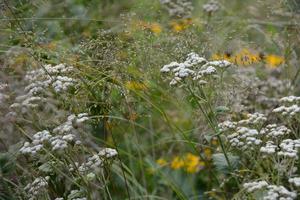Printed at http://www.newmoonnursery.com/index.cfm/
Parthenium integrifolium
Wild quinine
Native to North America
FIRST IMPRESSIONS: Parthenium integrifolium is a clump forming rhizomatous perennial wildflower. Plants produce bold rosettes of large coarsely serrate oval leaves. Stout flower stalks emerge from the rosettes bearing flat topped clusters of showy white flower heads. Pollinators flock to the blooms for about two months beginning in late spring. This tap rooted species thrives in dry or mesic prairie like setting or dry open woods.
HABITAT & HARDINESS: Parthenium integrifolium occurs in the eastern United States from Massachusetts to Georgia and west to Minnesota and Texas.
This species is indigenous to mesic Blackland prairies, sand prairies, savannas, barrens, limestone glades, rocky open woods and thickets. Plants are more likely to occur in high quality habitats and are usually absent from disturbed sites.
Plants are hardy in USDA Zones 4-8.
PLANT DESCRIPTION: Plants originate from a sturdy taproot. During winter coarse textured leaves are arranged in a basal rosette. Blades are 6” long and 4” wide on long stalks. They are ovate or cordate with coarse teeth along the edge.
Sturdy branched flower stalks with small leaves elongate from the rosettes and globular white flower heads form at the tip of each branch.
Each head is about 1/2” across and each consists of numerous disc flowers. The ray flowers are inconspicuous. Blooming continues for about 8 weeks from late spring into summer.
As the flowers wane, they transition into brown rounded clusters of achenes.
Plants are 2-4’ tall with a 2-3’ spread.
CULTURAL & MAINTENANCE NEEDS: Parthenium integrifolium grows best in sunny sites with fertile loamy or average well drained soil. Plants also adapt to lightly shaded sites, sandy, rocky or clay soils and drought.
This species need no irrigation or fertilizer.
Plants are pest resistant and the bitter rough leaves are unpalatable to deer and other herbivores.
LANDSCAPE USES: This distinctive species is a wonderful Accent Plant for a Wildlife Garden. In a Prairie or Meadow, scatter small Groups of plants in drifts among the grasses. Parthenium integrifolium is used as a fresh or dried Cut Flower and planted to provide Showy Blooms and Winter Interest. This species is a valuable component of Cottage Gardens, Deer Resistant Plantings, Rock Gardens, Water-wise Landscapes, Low Maintenance Plantings and Perennial Borders.
COMPANION & UNDERSTUDY PLANTS: Parthenium integrifolium mingles well with flowering prairie residents like Allium cernuum, Asclepias tuberosa, Echinacea purpurea and Liatris aspera. This species also combines beautifully with prairie grasses like Andropogon gerardii. Panicum virgatum, Sorghastrum nutans and Sporobolus heterolepis.
Achillea millefolium could be used as a substittute. Also, Eryngium yuccifolium might be used in a pinch. It has a similar growth habit, and grows in similar circumstances.
TRIVIA: Pollinators including native bees, beneficial wasps, flies and beetles seek nectar and pollen from the flowers.
At first glance, the flat topped flower clusters may appear to belong to the the Apiaceae or Umbelliferae (Carrot or Parsley) family. Instead, Parthenium integrifolium is a unique member of the Asteraceae or Compositae (Aster or Sunflower) family.
The bark of the cinchona tree contains quinine and was important in the early 1900’s as a treatment for malaria. During World War I the supply of cinchona was disrupted. Since Parthenium integrifolium also contained quinine, it was used as a substitute.
Height:
2-4 FeetSpread:
2-3 ftSpacing:
2-3 ftUSDA Hardiness Zone:
4-8Bloom Color:
WhiteParthenium integrifolium Characteristics
Attracts Wildlife
- Pollinators
- Butterflies
Attributes
- Dried Flower
- Cut Flower
- Naturalizing
- East-Coast Native
- Drought Tolerant
Exposure
- Sun/Light Shade
Deer Resistant
- Deer Resistant
Flowering Months
- August
- July
- June
- May
Foliage Color
- Green
Soil Moisture Preference
- Dry to Moist
- Moist
- Dry

